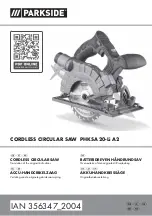
68
GB
Kickback causes and related warnings
Kickback is a sudden reaction of the workpiece due to a
pinched, jammed saw blade or misaligned line of cut in the
workpiece with respect to the saw blade or when a part of the
workpiece binds between the saw blade and the rip fence or
other fixed object.
Most frequently during kickback, the workpiece is lifted from
the table by the rear portion of the saw blade and is propelled
towards the operator. Kickback is the result of saw misuse and/
or incorrect operating procedures or conditions. And can be
avoided by taking proper precautions as given below.
a) Never stand directly in line with the saw blade.
Always position your body on the same side of
the saw blade as the fence.
Kickback may propel
the workpiece at high velocity towards anyone standing in
front and in line with the saw blade.
b) Never reach over or in back of the saw blade to
pull or to support the workpiece.
Accidental con-
tact with the saw blade may occur or kickback may drag
your fingers into the saw blade.
c) Never hold and press the workpiece that is be-
ing cut off against the rotating saw blade.
Press-
ing the workpiece being cut off against the saw blade will
create a binding condition and kickback.
d) Align the fence to be parallel with the saw
blade.
A misaligned fence will pinch the workpiece
against the saw blade and create kickback.
e) Use a featherboard to guide the workpiece
against the table and fence when making non-
through cuts such as rabbeting, dadoing or re-
sawing cuts.
A featherboard helps to control the work-
piece in the event of a kickback.
f) Use extra caution when making a cut into blind
areas of assembled workpieces.
The protruding
saw blade may cut objects that can cause kickback.
g) Support large panels to minimise the risk of saw
blade pinching and kickback.
Large panels tend to
sag under their own weight. Support(s) must be placed un-
der all portions of the panel overhanging the table top.
h) Use extra caution when cutting a workpiece that
is twisted, knotted, warped or does not have a
straight edge to guide it with a mitre gauge or
along the fence.
A warped, knotted, or twisted workpiece
is unstable and causes misalignment of the kerf with the saw
blade, binding and kickback.
i) Never cut more than one workpiece, stacked
vertically or horizontally.
The saw blade could pick
up one or more pieces and cause kickback.
j) When restarting the saw with the saw blade
in the workpiece, centre the saw blade in the
kerf so that the saw teeth are not engaged in
the material.
If the saw blade binds, it may lift up the
workpiece and cause kickback when the saw is restarted.
k) Keep saw blades clean, sharp, and with suffi-
cient set. Never use warped saw blades or saw
blades with cracked or broken teeth.
Sharp and
properly set saw blades minimise binding, stalling and kick-
back.
Table saw operating procedure warnings
a) Turn off the table saw and disconnect the pow-
er cord when removing the table insert, chang-
ing the saw blade or making adjustments to
the riving knife or saw blade guard, and when
the machine is left unattended.
Precautionary meas-
ures will avoid accidents.
b) Never leave the table saw running unattended.
Turn it off and don’t leave the tool until it comes
to a complete stop.
An unattended running saw is an
uncontrolled hazard.
c) Locate the table saw in a well-lit and level area
where you can maintain good footing and bal-
ance. It should be installed in an area that pro-
vides enough room to easily handle the size of
your workpiece.
Cramped, dark areas, and uneven
slippery floors invite accidents.
d) Frequently clean and remove sawdust from
under the saw table and/or the dust collection
device.
Accumulated sawdust is combustible and may
self-ignite.
e) The table saw must be secured.
A table saw that is
not properly secured may move or tip over.
f) Remove tools, wood scraps, etc. from the table
before the table saw is turned on.
Distraction or a
potential jam can be dangerous.
g) Always use saw blades with correct size and
shape (diamond versus round) of arbour holes.
Saw blades that do not match the mounting hardware of
the saw will run off-centre, causing loss of control.
h) Never use damaged or incorrect saw blade
mounting means such as flanges, saw blade
washers, bolts or nuts.
These mounting means were
specially designed for your saw, for safe operation and op-
timum performance.
i) Never stand on the table saw, do not use it as a
stepping stool.
Serious injury could occur if the tool is
tipped or if the cutting tool is accidentally contacted.
j) Make sure that the saw blade is installed to ro-
tate in the proper direction. Do not use grinding
wheels, wire brushes, or abrasive wheels on a
table saw.
Improper saw blade installation or use of accessories not
recommended may cause serious injury.
Safety instructions for the handling of saw blades
1. Only use insertion tools if you have mastered their use.
2. Observe the maximum speed. The maximum speed speci-
fied on the insertion tool may not be exceeded. If specified,
observe the speed range.
3. Observe the motor / saw blade direction of rotation.
4. Do not use any insertion tools with cracks. Sort out cracked
insertion tools. Repairs are not permitted.
5. Clean dirt, grease, oil and water off of the clamping surfaces.
6. Do not use any loose reducing rings or bushes to reduce
holes on circular saw blades.
7. Make sure that fixed reducer rings for securing the inser-
tion tool have the same diameter and have at least 1/3 of
the cutting diameter.
Содержание PTKS 2000 F4
Страница 87: ......















































